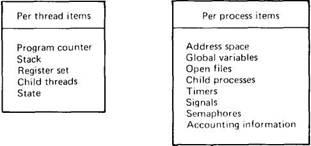Книга: Distributed operating systems
4.1.1. Introduction to Threads
4.1.1. Introduction to Threads
Consider, for example, a file server that occasionally has to block waiting for the disk. If the server had multiple threads of control, a second thread could run while the first one was sleeping. The net result would be a higher throughput and better performance. It is not possible to achieve this goal by creating two independent server processes because they must share a common buffer cache, which requires them to be in the same address space. Thus a new mechanism is needed, one that historically was not found in single-processor operating systems.

Fig. 4-1. (a) three processes with one thread each. (b) One process with three threads.
In Fig. 4-1 (a) we see a machine with three processes. Each process has its own program counter, its own stack, its own register set, and its own address space. The processes have nothing to do with each other, except that they may be able to communicate through the system's interprocess communication primitives, such as semaphores, monitors, or messages. In Fig. 4-l(b) we see another machine, with one process. Only this process contains multiple threads of control, usually just called threads, or sometimes lightweight processes. In many respects, threads are like little mini-processes. Each thread runs strictly sequentially and has its own program counter and stack to keep track of where it is. Threads share the CPU just as processes do: first one thread runs, then another does (timesharing). Only on a multiprocessor do they actually run in parallel. Threads can create child threads and can block waiting for system calls to complete, just like regular processes. While one thread is blocked, another thread in the same process can run, in exactly the same way that when one process blocks, another process in the same machine can run. The analogy: thread is to process as process is to machine, holds in many ways.
Different threads in a process are not quite as independent as different processes, however. All threads have exactly the same address space, which means that they also share the same global variables. Since every thread can access every virtual address, one thread can read, write, or even completely wipe out another thread's stack. There is no protection between threads because (1) it is impossible, and (2) it should not be necessary. Unlike different processes, which may be from different users and which may be hostile to one another, a process is always owned by a single user, who has presumably created multiple threads so that they can cooperate, not fight. In addition to sharing an address space, all the threads share the same set of open files, child processes, timers, and signals, etc. as shown in Fig. 4-2. Thus the organization of Fig. 4-1(a) would be used when the three processes are essentially unrelated, whereas Fig. 4-1(b) would be appropriate when the three threads are actually part of the same job and are actively and closely cooperating with each other.

Fig. 4-2. Per thread and per process concepts.
Like traditional processes (i.e., processes with only one thread), threads can be in any one of several states: running, blocked, ready, or terminated. A running thread currently has the CPU and is active. A blocked thread is waiting for another thread to unblock it (e.g., on a semaphore). A ready thread is scheduled to run, and will as soon as its turn comes up. Finally, a terminated thread is one that has exited, but which has not yet been collected by its parent (in UNIX terms, the parent thread has not yet done a WAIT).




